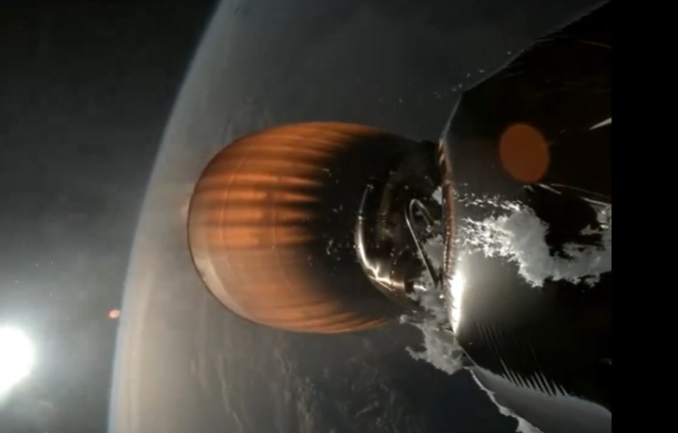A routine launch of a Falcon 9 by SpaceX turned into anything but for the industry behemoth.
At 0235 GMT on 12 July a Falcon 9 v1.2FT Block 5 rocket, carrying Starlink Group 9-3, rose from its launch pad at Vandenberg, California, US. The Starlinks onboard were a set of 20 v2 Mini communications satellites, 13 of which had Direct-to-Cell capability. Initially, all went well: there was a good first stage burn and drop off, and the B1063 first stage was safely recovered to drone barge ‘Of Course I Still Love You’ located downrange in the Pacific.
However, imagery from onboard cameras showed that frozen white ice had built up on the outside of the stage towards the engine during the second stage orbital injection burn. The engine appeared to continue functioning normally, but the orbit was still unstable with a very low 138 km perigee. It was supposed to be raised by an engine burn to circularise the orbit to above 300 km. The only problem was that an “RUD (Rapid Unscheduled Disassembly)” had befallen the rocket at ignition, according to SpaceX founder Elon Musk. In other words, it had exploded.
The blast could not have been too violent given that SpaceX was later able to deploy all 20 satellites, in the hope that at least some would be able to reach a more stable orbit. The satellites’ electric propulsion has a low thrust which may not be enough to overcome atmospheric drag at that low altitude. As Musk put it in a post on his X platform (formerly Twitter): “We’re updating satellite software to run the ion thrusters at their equivalent of warp 9. Unlike a Star Trek episode, this will probably not work, but it’s worth a shot.”
Further Falcon 9 launches were suspended until a full investigation into the failure, with the involvement of the Federal Aviation Authority (FAA), was concluded.
Update on 29 July: Two satellites, Starlink 11214 and Starlink 11202, from this launch were tracked, albeit in very low orbits with perigees of circa 180 km. These two satellites may just have been able to counter atmospheric drag using their electric thrusters, which is an interesting practical experiment for those planning to use VLEO (Very Low Earth Orbits). Starlink 11214 eventually re-entered at 1444 GMT on 16 July, followed by Starlink 11202 at 1541 on 20 July. All the other satellites are thought to have been lost to a premature re-entry, probably within a day of the launch.
The investigation found that during the first burn of the second stage engine, a liquid oxygen leak developed within the insulation around the upper stage engine. The cause of the leak was identified as a crack in a ‘sense line’ (tap off) for a pressure sensor attached to the Falcon 9’s oxygen system. The line had cracked due to fatigue, caused by high loading from engine vibration and looseness in the clamp that normally constrains the line. Despite the leak, the second stage engine continued to operate through the duration of its first burn and completed its engine shutdown, where it entered the coast phase of the mission in the intended elliptical parking orbit.
A second burn of the upper stage engine was planned to circularise the orbit ahead of satellite deployment. However, the liquid oxygen leak on the upper stage led to the excessive cooling of engine components, most importantly those associated with delivery of ignition fluid to the engine. As a consequence, the engine experienced a hard start, rather than a controlled burn, that damaged the engine hardware and caused the upper stage to lose attitude control. Even so, the second stage continued to operate as designed: it deployed the Starlink satellites, albeit in a low orbit, and successfully completed stage passivation venting. The ‘sense line’ tap off has been disabled for resumed Falcon 9 flights which restarted on 27 July.

Here is an image of the white frozen propellant seen building up on outside of the upper stage during ascent burn. It was on the subsequent burn that the explosion happened. Courtesy: SpaceX
Comment by David Todd: This failure is unusual. Most rockets built by experienced organisations have early ‘teething trouble’ failures, followed by long periods of smooth operations which Seradata dubs as the ‘Nirvana’ stage in a rocket’s lifespan. Of course, random failures can, and do, still occur now and then. According to Slingshot Aerospace’s Seradata database, the SpaceX Falcon 9/Falcon Heavy family has had four launcher related failures, although most of these were minor. The last two failures involved dispenser incidents in 2023 in which a few spacecraft remained attached to the second stage.
Before that, Falcon 9 had a major launch failure in 2015 involving a second stage tank explosion. This lost the Dragon CRS-07 cargo mission for NASA and eight small Flock cubesats. In 2012 another failure involved a first stage engine shutdown resulting in the stranding of a secondary payload. The Falcon 9 and its derivative, the Falcon Heavy, has flown over 363 times. The rocket also had a major pre-launch explosion involving a tank failure destroying the Amos-6 communications satellite.
While not a launch vehicle related failure, a Falcon 9 launch went wrong in February 2022 because the satellites’ mission design resulted in a planned low deployment orbit, but that turned out to be too low after a solar storm resulted in much more atmospheric drag than expected. This caused the premature re-entry of most of the spacecraft (38 out of the 59 carried) before they were able to climb out of trouble.







